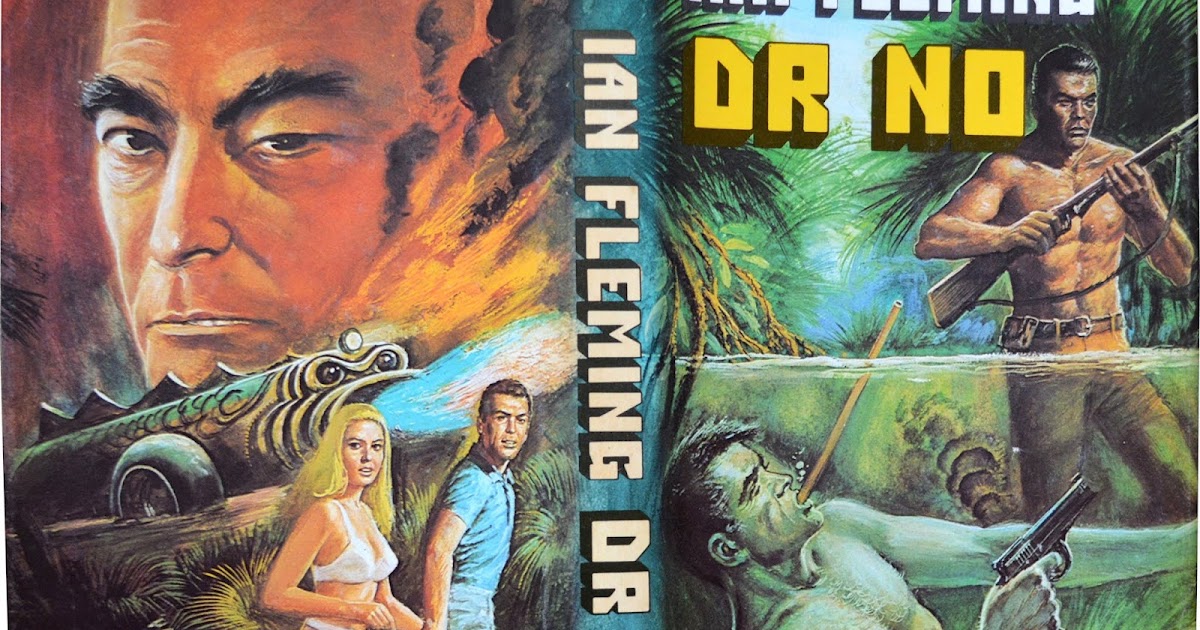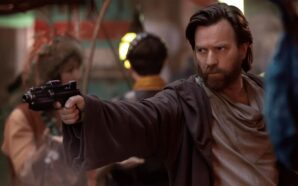Keeping Bond’s fate a mystery after the cliffhanger ending of From Russia with Love, Dr No begins with M arriving at the Regent’s Park office of the Secret Service, and Fleming takes the time to flesh out the perfunctory supporting character. Largely, M just mutters things like “Nowadays softness was everywhere,” like he’s auditioning for a hosting gig on GB News, but spending time with a much older man of an earlier generation proves to be an interesting comparison when Bond does enter the scene and has to question whether he’s now obsolete after his failed mission. A phone call to a doctor reveals Bond has survived, though just barely, having been saved by Mathis after being poisoned by Fugu, and has been resting, somewhat restlessly, in hospital for weeks. As for his would-be assassin, Klebb’s fate is both hilariously and curtly revealed: “Oh, she died.”
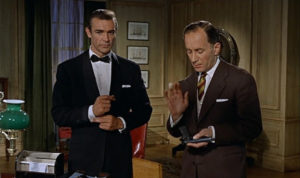 Bond enters M’s office and has to choose a new gun just like M has to choose an agent, the right weapon for the job, and there’s now a question of if Bond is the right choice. I really like these parallels while they last, and Bond is sad to see his Beretta go, which is deemed a “ladies’ gun.” It failed him on his last assignment and he’s forced to cut it loose and replace it. How long until M does the same to him, a fellow broken weapon? Bond is given a Smith & Wesson and the classic Walther PPK by the armorer Major Boothroyd, a cold and humourless man who certainly is no Q. Bernard Lee’s M from the early films is a great, true adaptation of Fleming’s character from the novels but I’m glad the films diverged when it came to Moneypenny and Q, giving the side characters more personality than what is on the page.
Bond enters M’s office and has to choose a new gun just like M has to choose an agent, the right weapon for the job, and there’s now a question of if Bond is the right choice. I really like these parallels while they last, and Bond is sad to see his Beretta go, which is deemed a “ladies’ gun.” It failed him on his last assignment and he’s forced to cut it loose and replace it. How long until M does the same to him, a fellow broken weapon? Bond is given a Smith & Wesson and the classic Walther PPK by the armorer Major Boothroyd, a cold and humourless man who certainly is no Q. Bernard Lee’s M from the early films is a great, true adaptation of Fleming’s character from the novels but I’m glad the films diverged when it came to Moneypenny and Q, giving the side characters more personality than what is on the page.
“Courage is a capital sum reduced by expenditure.” Bond has been out of action for months and M asks him whether he wants to continue as a 00. He does, of course, and hates the question, vowing to prove himself on whatever mission he’s given. M plans to send Bond to Jamaica, a nothing case, a paid holiday even, investigating the disappearance of his agent Strangways who was looking into the island of Crab Key, owned by a mysterious doctor, where the only action to be found is the harvesting of guano, a type of bird dung. He’s sure Strangways simply eloped with his secretary and this is an excuse to get Bond out there and make him head of station in Jamaica while he investigates. Could Bond begin to think about retirement or will M force it on him? I love the office politics and M’s machinations in the novels. Bond goes from speaking of his love of M in books past to now “for the first time in his life he hated the man. In a way Bond felt sure he was being sent on this cushy assignment to humiliate him.”
 The travelogue elements of Fleming’s novels often feel the most dated when reading them almost 70 years after they were written. While reading of luxurious air travel and the almost fantastical United States may have riveting in the 1950s, today it holds little wonder. Yet Dr No manages to succeed on this level when discussing Jamaica, Fleming’s home. For the first time I wasn’t rushing through the copious descriptions of location and ambiance. Jamaica sounds lovely and, at least to me, still holds a little of that international intrigue that a New York airport lounge doesn’t. Fleming’s writing almost radiates the heat and atmosphere of the Caribbean, engulfing the reader, especially during a British winter. The contrast in weather between the cold rain of England and the warm sun of Jamaica are continually highlighted, maybe a little too much. It’s a nice contrast but it does begin to feel like Fleming rubbing it in a bit and bragging about his decision to move to the island.
The travelogue elements of Fleming’s novels often feel the most dated when reading them almost 70 years after they were written. While reading of luxurious air travel and the almost fantastical United States may have riveting in the 1950s, today it holds little wonder. Yet Dr No manages to succeed on this level when discussing Jamaica, Fleming’s home. For the first time I wasn’t rushing through the copious descriptions of location and ambiance. Jamaica sounds lovely and, at least to me, still holds a little of that international intrigue that a New York airport lounge doesn’t. Fleming’s writing almost radiates the heat and atmosphere of the Caribbean, engulfing the reader, especially during a British winter. The contrast in weather between the cold rain of England and the warm sun of Jamaica are continually highlighted, maybe a little too much. It’s a nice contrast but it does begin to feel like Fleming rubbing it in a bit and bragging about his decision to move to the island.
Bond visited Jamaica last in Live and Let Die and so Dr No sees the return of some supporting characters from that novel. Strangways is promptly killed but wasn’t much of a character anyway, while Quarrel is much more engaging. Sure, he’s another in the trope of the friendly, informative native who shows Bond around and imparts local wisdom, but he’s a fun character. Quarrel is a fisherman so finds much excitement in his new role as a spy, countering Bond’s initial frustration and doubts, and the friendly Jamaican soon proves to be exactly the friend Bond needs to bring him out of his funk. Fleming clearly likes Jamaicans but he sure is patronising and the 1950’s racism again flows freely: “The Jamaican is a kindly lazy man with the virtues and vices of a child.” The Chinese bear the brunt too and if a character happens to have both Jamaican and Chinese heritage, like the eponymous villain’s henchmen, then Fleming has twice the offensive ammunition.
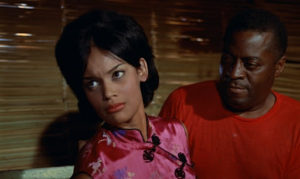 Bond travels to Jamaica to prove himself but makes several rookie mistakes. He announces his arrival to the local authorities and so is followed from the airport by one of Dr No’s goons, the local paper’s photographer Annabel Chung. Along with Quarrel, he threatens the woman and almost breaks her arm but, when she doesn’t reveal who she’s working for, refuses to follow through on the assault. Bond couldn’t even get information out of a journalist and then couldn’t bring himself to harm her, in front of Quarrel no less. I like that for the first half of the book Bond is frustrated at himself, questioning whether he still has what it takes to be a 00, and the reader is questioning it too.
Bond travels to Jamaica to prove himself but makes several rookie mistakes. He announces his arrival to the local authorities and so is followed from the airport by one of Dr No’s goons, the local paper’s photographer Annabel Chung. Along with Quarrel, he threatens the woman and almost breaks her arm but, when she doesn’t reveal who she’s working for, refuses to follow through on the assault. Bond couldn’t even get information out of a journalist and then couldn’t bring himself to harm her, in front of Quarrel no less. I like that for the first half of the book Bond is frustrated at himself, questioning whether he still has what it takes to be a 00, and the reader is questioning it too.
Sadly, this idea is steadily dropped as the novel continues and at one point Bond’s actions lead to two innocent men being murdered after he paid them to drive his car to the other side of the island as a distraction. All Bond does is burn the newspaper he reads about it in and then never thinks of it again. I wish it haunted him and that Bond commented on it further. Fleming wants the character to be vulnerable but is only willing to explore that aspect to a certain degree. He’s still a hero, even if the plot suggests otherwise, and it makes the characterisation in Dr No feel like a half measure.
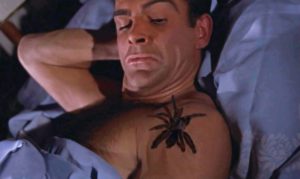 Bond’s trip to Jamaica is hardly the paid holiday he was promised and he soon has to survive both a poisoning attempt and “five inches of grey-brown, shiny death,” AKA a centipede, in his bed. Bond’s encounter with the arthropod is one of the best chapters of the book and, to someone terrified of creepy crawlies, the description of Bond waking up and feeling it slowly crawling up his body is terrifying. What makes it better is that Bond acts in a totally relatable way, at first being paralysed with terror and then suddenly and awkwardly leaping out of bed, limbs flailing, and shaking with fear. Across all the books, Bond seems especially concerned with a certain part of his body, and twice encounters an animal trying to unman him in Dr No. “God, it was turning down towards his groin! Bond set his teeth! Supposing it liked the warmth there! Supposing it tried to crawl into the crevices! Could he stand it? Supposing it chose that place to bite?”
Bond’s trip to Jamaica is hardly the paid holiday he was promised and he soon has to survive both a poisoning attempt and “five inches of grey-brown, shiny death,” AKA a centipede, in his bed. Bond’s encounter with the arthropod is one of the best chapters of the book and, to someone terrified of creepy crawlies, the description of Bond waking up and feeling it slowly crawling up his body is terrifying. What makes it better is that Bond acts in a totally relatable way, at first being paralysed with terror and then suddenly and awkwardly leaping out of bed, limbs flailing, and shaking with fear. Across all the books, Bond seems especially concerned with a certain part of his body, and twice encounters an animal trying to unman him in Dr No. “God, it was turning down towards his groin! Bond set his teeth! Supposing it liked the warmth there! Supposing it tried to crawl into the crevices! Could he stand it? Supposing it chose that place to bite?”
Bond and Quarrel return to the same house they inhabited in Live and Let Die and once again spend a week training to get Bond back into shape. He remembers Solitaire and has nightmares about his dive to Mr Big’s island, although it doesn’t feel too repetitive because Fleming whizzes through this section. The book spends eighty pages on a single day and then rushes through a week in just one. Thankfully the novel has a very quick pace, and Fleming often utilises short sentences, which I should definitely learn from. It is fairly ridiculous however that there are two supervillains on two islands in the same few square miles off the coast of Jamaica: Mr Big and Dr No. Crab Key is much larger however and, when Bond investigates, it at first seems like a paradise but soon becomes a dark gauntlet of dangers, likened to a penal colony. As Quarrel says, in Fleming’s attempt at dialect, “Tell da trut cap’n, dat Crab Key scare me plenty.”
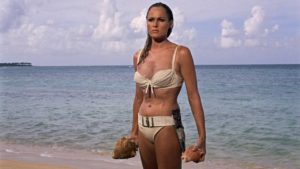 It’s on Crab Key where Bond encounters his love interest for the novel, Honeychile Ryder, who is described as looking like Botticelli’s Venus but with a broken nose. “Already, as he found so often when people had deformities, he had almost forgotten her broken nose.” This line really surprised me because, despite their other problematic elements, the Bond novels have much less of a body fascism problem than the films. While the villains all have physical differences and abnormalities, so do the heroes, such as Honey’s nose, Bond’s scar on his cheek, and Felix Leiter’s shark-attack injuries, which the films refuse to translate to screen. Although Fleming again uses rape as a pivotal part of a Bond girl’s backstory, with Honey having been sexually assaulted before killing her attacker with a Black Widow spider. Despite that, Honey has the very strange dream of being a high-end call girl in New York.
It’s on Crab Key where Bond encounters his love interest for the novel, Honeychile Ryder, who is described as looking like Botticelli’s Venus but with a broken nose. “Already, as he found so often when people had deformities, he had almost forgotten her broken nose.” This line really surprised me because, despite their other problematic elements, the Bond novels have much less of a body fascism problem than the films. While the villains all have physical differences and abnormalities, so do the heroes, such as Honey’s nose, Bond’s scar on his cheek, and Felix Leiter’s shark-attack injuries, which the films refuse to translate to screen. Although Fleming again uses rape as a pivotal part of a Bond girl’s backstory, with Honey having been sexually assaulted before killing her attacker with a Black Widow spider. Despite that, Honey has the very strange dream of being a high-end call girl in New York.
Honey is incredibly childlike, innocent of the wider world, and talks like a little girl in a way that’s fairly awkward considering her role as a male fantasy character. Even Bond is off-put by it. “One could not make love to a child. But was she a child?” She’s simply a sweet innocent native girl, yet white of course, Fleming makes that clear. The “poor little bitch” thinks the danger she’s in is just a game at first but her and Bond do develop a good conflict, with Honey knowing more about nature, which they use to survive the island’s dangers, while he knows more about the human enemy and their tactics. Ryder has a connection with animals, having “lived with snakes and things” since she was a child after her family mansion burned down with her parents inside, and the connection at times feels almost supernatural. She’s one small step away from being a Disney princess.
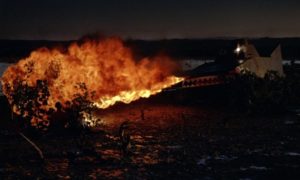 Honeychile is the first Bond girl to not be introduced as an integral part of the plot; she just happens to be in the wrong place at the wrong time, hunting for shells on Crab Key as Bond makes his arrival on the island. She’s involved simply because it’s part of the formula, although her presence does allow for maybe the funniest line out of the six novels so far: “Without waiting for her reply the two men took off their trousers.” Bond, Quarrel and Honey make their way deeper into the island to discover what deadly secret it holds, all while trying to hide from Dr No’s private army. This culminates in a fight with a dragon which, thankfully, isn’t a dragon at all but rather a big tractor with a flamethrower taped to the front. Quarrel is killed and Bond feels he’s failed his friend, another mistake to add to the roster, as he and Honey are captured.
Honeychile is the first Bond girl to not be introduced as an integral part of the plot; she just happens to be in the wrong place at the wrong time, hunting for shells on Crab Key as Bond makes his arrival on the island. She’s involved simply because it’s part of the formula, although her presence does allow for maybe the funniest line out of the six novels so far: “Without waiting for her reply the two men took off their trousers.” Bond, Quarrel and Honey make their way deeper into the island to discover what deadly secret it holds, all while trying to hide from Dr No’s private army. This culminates in a fight with a dragon which, thankfully, isn’t a dragon at all but rather a big tractor with a flamethrower taped to the front. Quarrel is killed and Bond feels he’s failed his friend, another mistake to add to the roster, as he and Honey are captured.
In No’s compound, Bond and Honey are taken to the “mink-lined prison”, a fancy hotel room where they are treated like guests rather than prisoners. This is a classic Bond trope making its debut and I never fail to find the contrast between the pampered luxury and incredible danger really fun, and it’s a great display of Dr No’s power over them. Yet despite the danger and seeing someone burned alive an hour beforehand, Honey is desperate to sleep with Bond and the agent has to muster all his willpower to refuse. “You must stay cold as ice to have any chance of getting out of this mess. Later! Later! Don’t be weak.” She really is a 50’s version of a childlike Waifu who won’t leave Bond alone, and to make her seem like even more of a young girl Bond has to run her a bath because she’s never had one before. “Honey, get into that bath before I spank you.” I find the character grating.
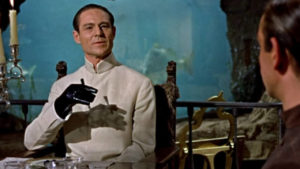 For most of the novel, Fleming is building mystery surrounding Dr No, begging the reader to ask who this mysterious, oft-mentioned, greatly-feared man is. Such a build-up could easily end in disappointment but the grand unveiling of No and his first interaction with Bond epitomises what a villain in this series can and should be. After toying with aspects of the now heavily-pastiched bad guys in previous works, most notably Hugo Drax, Fleming writes the classic, ultimate Bond villain. The cold, evil, almost emotionless megalomaniac who embraces his insanity and channels it into the goal of world domination. Visually too, No is suitably grotesque. “The bizarre, gliding figure looked like a giant venomous worm wrapped in grey tin-foil.” The Chinese-German has contorted his body to change his identity, wears his heart on the other side of his chest, and now has metal pincers for hands. Humorously, Fleming also treats his contact lenses as something weird and slightly disturbing, which I guess they must have been back in the 1950s.
For most of the novel, Fleming is building mystery surrounding Dr No, begging the reader to ask who this mysterious, oft-mentioned, greatly-feared man is. Such a build-up could easily end in disappointment but the grand unveiling of No and his first interaction with Bond epitomises what a villain in this series can and should be. After toying with aspects of the now heavily-pastiched bad guys in previous works, most notably Hugo Drax, Fleming writes the classic, ultimate Bond villain. The cold, evil, almost emotionless megalomaniac who embraces his insanity and channels it into the goal of world domination. Visually too, No is suitably grotesque. “The bizarre, gliding figure looked like a giant venomous worm wrapped in grey tin-foil.” The Chinese-German has contorted his body to change his identity, wears his heart on the other side of his chest, and now has metal pincers for hands. Humorously, Fleming also treats his contact lenses as something weird and slightly disturbing, which I guess they must have been back in the 1950s.
Because he hasn’t had anyone intelligent to talk to for quite some time, Dr No tells Bond the story of his life in a rather unnecessary monologue. Some explanation is needed, and ironically Safin from No Time to Die, a villain heavily inspired by Dr No, could have used such a monologue, but I was enjoying the mystery of No so finding out he was a student in Milwaukee takes away some of his enigmatic threat. And him calling himself ‘No’ to represent his rejection of authority is laughable. Yet, in general, Bond and No’s long discussion about power and philosophy is my favourite part of the novel, as the two compare the power over life they both possess. Bond states, “Any man with a loaded revolver has the power of life and death over his neighbour. Your search for power is an illusion because power itself is an illusion.”
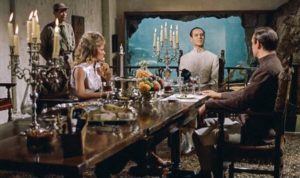 What makes the dinner between Bond, Honey and the bad doctor so enjoyable is how Fleming writes Bond in this situation. To try and present himself as unfazed by No’s threats, Bond becomes the most ‘Bond-y’ he’s been so far, the character I recognise more from the movies, casually refilling his glass and lighting a cigarette as he hears the pain and torture that is to come. Dr No never wastes human material and is interested in the data of death, experimenting with ways to kill his foes and monitor the results for future executions. Honey is to be tied naked to the shore and eaten by crabs and Bond will be put through an assault course too dangerous for even Takeshi’s Castle. Oh, but before that happens, No has to very briefly explain his master plan which I’m treating here as a weird addendum because that’s also how Fleming treats it. Out of the blue it’s revealed that No is messing with US rockets flying overhead for the highest bidder, currently the Russians, and this is never mentioned again or vital to the plot. Just an outlet for his villainy, I guess.
What makes the dinner between Bond, Honey and the bad doctor so enjoyable is how Fleming writes Bond in this situation. To try and present himself as unfazed by No’s threats, Bond becomes the most ‘Bond-y’ he’s been so far, the character I recognise more from the movies, casually refilling his glass and lighting a cigarette as he hears the pain and torture that is to come. Dr No never wastes human material and is interested in the data of death, experimenting with ways to kill his foes and monitor the results for future executions. Honey is to be tied naked to the shore and eaten by crabs and Bond will be put through an assault course too dangerous for even Takeshi’s Castle. Oh, but before that happens, No has to very briefly explain his master plan which I’m treating here as a weird addendum because that’s also how Fleming treats it. Out of the blue it’s revealed that No is messing with US rockets flying overhead for the highest bidder, currently the Russians, and this is never mentioned again or vital to the plot. Just an outlet for his villainy, I guess.
The deadly assault course Bond has to journey through consists primarily of a maze of air vents that make him feel like a TV dinner. The obstacles are a little disappointing. It’s a return of the pulp adventure serial aspects of the series as Bond has to shimmy up a pipe like he’s on Ninja Warrior and then quickly clamber across a hot section of floor which burns his clothes and skin. It even goes full Bushtucker Trial when Bond comes to an enclosure of tarantulas, which he gets through by crushing them into a satisfying pulp. But while the methods of torture are uninspired, the pain Bond feels is expertly described and tough to read, with Bond screaming throughout. The fact that eyes keep appearing at portholes along the course, watching him and charting his progress, is especially disturbing. And, rather perfectly considering how much it dominates Bond’s thoughts and Fleming’s writing, it’s the idea of breakfast, the smell of bacon and eggs sizzling, that drives Bond forward in the final moments of the gauntlet.
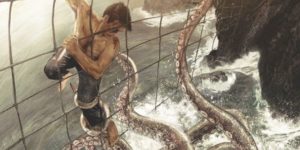 Earlier in the novel, Quarrel introduces Bond to a friend of his who once had a tussle with a giant squid and, in maybe the finest display of Chekhov’s squid, that cephalopod returns to attempt to kill Bond. I do love a giant squid. I remember reading through the Harry Potter series as a child and thinking the wizards and everything were fine but when were we going to find out more about the giant squid in the lake? It’s as close to an alien as you can get in a Bond story and Fleming, with a bucketload of fifties ignorance, paints the animal as a fantastical, evil beast similar to a Kraken, actively attempting to kill Bond. It’s the most ludicrous and pulpy sequence of the novels so far but, undoubtably, a fun one. “God, what a thing to have dreamed up!”, Bond exclaims, seemingly cursing Fleming. And, as with every giant monster in a book, TV show, or film, Bond kills the beast by stabbing it in the eye.
Earlier in the novel, Quarrel introduces Bond to a friend of his who once had a tussle with a giant squid and, in maybe the finest display of Chekhov’s squid, that cephalopod returns to attempt to kill Bond. I do love a giant squid. I remember reading through the Harry Potter series as a child and thinking the wizards and everything were fine but when were we going to find out more about the giant squid in the lake? It’s as close to an alien as you can get in a Bond story and Fleming, with a bucketload of fifties ignorance, paints the animal as a fantastical, evil beast similar to a Kraken, actively attempting to kill Bond. It’s the most ludicrous and pulpy sequence of the novels so far but, undoubtably, a fun one. “God, what a thing to have dreamed up!”, Bond exclaims, seemingly cursing Fleming. And, as with every giant monster in a book, TV show, or film, Bond kills the beast by stabbing it in the eye.
Dr No’s death is shit. I mean, literally, it’s shit. After escaping, Bond happens upon No at the island’s dock and promptly redirects a conveyor belt to deliver its payload down the evil doctor’s throat and buries him, suffocating him to death. The material in question is guano: bird shit. There’s not even a final conversation or confrontation as Bond quickly buries No and runs off, shouting “Now you take it Doctor No!” It’s so lame and disappointing and something the film definitely improved upon. Before leaving the island, Bond finds Honey who has also escaped because it turns out No’s plan of feeding her to crabs was nonsense. She even laughs about it. Crabs don’t kill people! The end of Dr No feels very much like Fleming pointing out the stupidity and ridiculousness of the novel. Even he can’t keep a straight face at this point.
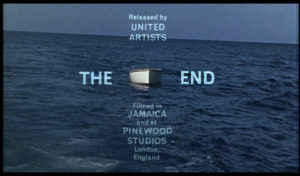 In the final chapter, Bond reflects on his adventure. No will go to Hell, Quarrel to Heaven. A place of warmth and a place of cold, like Jamaica and London. Where will Bond go when he dies? He’s proved himself on this mission but who as? There’re teases of Fleming trying to say something but he pulls back. There are plenty of opportunities to tie up thematic threads but the ending refuses, maybe because Bond refuses. Yet it feels cheap. The novel concludes with little comment on anything. Just sex; Bond and Honey finally hook up. The themes and ideas of Bond not having what it takes, having his abilities questioned, that are so prominent at the beginning totally fade away and his success is supposed to speak for itself when I would have preferred some comment on the subject.
In the final chapter, Bond reflects on his adventure. No will go to Hell, Quarrel to Heaven. A place of warmth and a place of cold, like Jamaica and London. Where will Bond go when he dies? He’s proved himself on this mission but who as? There’re teases of Fleming trying to say something but he pulls back. There are plenty of opportunities to tie up thematic threads but the ending refuses, maybe because Bond refuses. Yet it feels cheap. The novel concludes with little comment on anything. Just sex; Bond and Honey finally hook up. The themes and ideas of Bond not having what it takes, having his abilities questioned, that are so prominent at the beginning totally fade away and his success is supposed to speak for itself when I would have preferred some comment on the subject.
Dr No is a simple, formulaic story that plays out in an incredibly straightforward, linear way. It’s far less interesting and thoughtful than its predecessor, From Russia with Love, but I can see why it was chosen to be adapted into the first film. It’s much more contained than the sprawling adventures of the last few novels. Even Bond himself comments on the clear formula of his assignments at this stage, and Fleming has embraced it: “It had the right ingredients – physical exertion, mystery, and a ruthless enemy. He had a good companion. His cause was just.” But while Dr No may condense everything and put all the elements into a single package, it isn’t the best example of any of them, other than maybe the villain. It’s a fun read but one of the more disposable James Bond novels.
Stay tuned to OutofLives for my thoughts on the seventh of Fleming’s Bond novels, Goldfinger, in the coming weeks.




